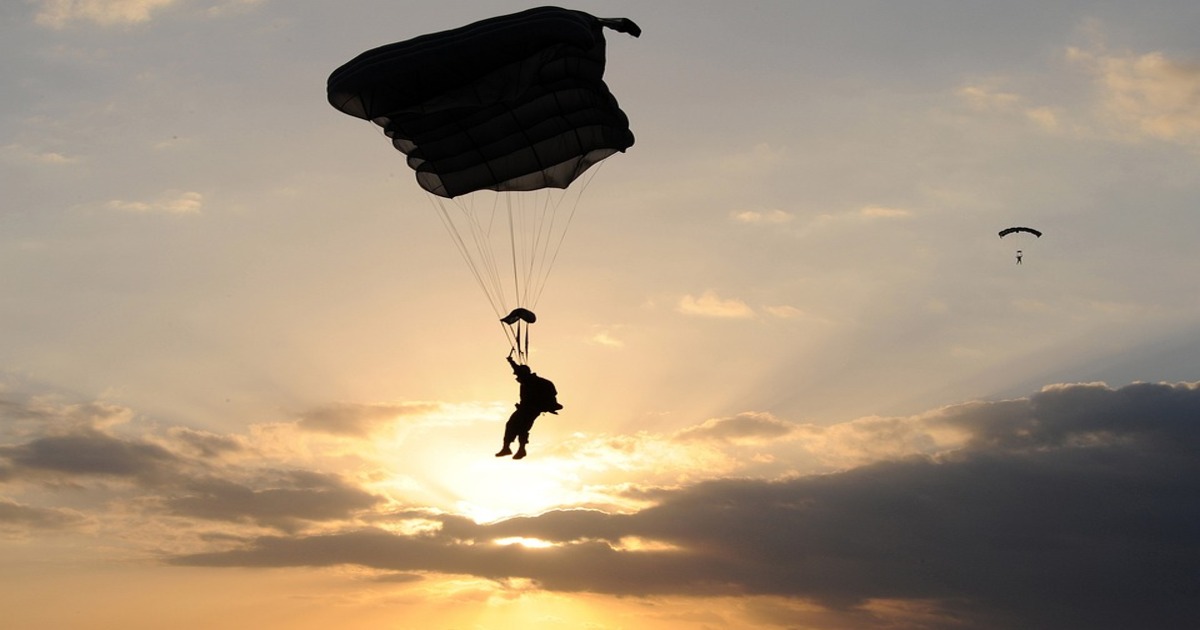Experiencing the UK In Freefall (Not a Brexit Story)
Skydiving has evolved into a global phenomenon. It contains some risk, but the experience is an epic one.
April 8, 2023

For most of us, the idea of free-falling from an aircraft at high altitude and landing by parachute requires serious calculation.
A natural instinct of self-preservation kicks in at the prospect of actually doing it. We can very easily reject the idea out of hand, or happily consign it to a notional “bucket-list,” unlikely to be completed in our lifetimes.
Even if we remain mildly curious, perhaps for years, we are still likely to ask: “could I do this, without numbing fear, or potential injury”? The answer is yes, and for many people the experience is an epic one.
An age-old story
Parachuting itself is an old story, with designs evolving from the concepts of artist Leonardo Da Vinci in the 15th century and from French versions in the late 18th century. The first (American) parachute jump from an aircraft took place in 1911.
Parachute design and partial military use advanced during the First World War, to the round silk canopy types used in the Second World War by aircrew bailing out and by paratroopers.
During 1940-1945, major parachute operations were carried out by German, U.S., British and Polish airborne units, dropped by static lines from around 800 feet to the battlefield.
Enter skydiving
Skydiving (sport parachuting) took things further, with the first international high-altitude competitions held in the 1950s, accompanied ever since by advancing safety equipment, technological and materials design improvements.
Today, skydiving has gone global, and is licenced in over 100 countries. Skydive parachutes have evolved out of all recognition, sporting large rectangular nylon canopies with dual cord controls, offering tandem jumpers the chance to steer the canopy at the instructor’s discretion.
Once deployed, the canopy is effectively an aircraft itself and is highly maneuverable. At a minimum, all skydiving instructors are equipped with main and reserve parachutes, the latter designed to activate automatically at 2,000 feet.
What to expect
What can you expect today if you decide to skydive? Here’s a British version. The basic, thrilling option is a tandem jump, controlled totally by an instructor harnessed to you.
There are no age limits for tandem jumps in the UK (you should be under 50 years of age for solo training).
As a middle-aged novice, never having jumped before, I elected for a tandem jump from 10,000 feet (the normal skydive jump altitude is between 10,000-15,000 feet where an oxygen supply is not needed).
Tandem skydiving is safe but not risk-free. In 2022 the sport’s UK regulator – British Skydiving – calculated the risk of tandem jumps in the UK as 1 injury for each 1,200 jumps, 1 fatality per 880,000 jumps since 1990.
There have been no tandem fatalities in the UK since 2002. In other words, it’s far safer than your chance of dying in most forms of transport, as a pedestrian, by drowning, fire or lightning (National Safety Council statistics). And the injuries that do occur are usually minor.
The balance of risk
I decided that the balance of risk appeared to be in my favor. Even so, I will admit to being on edge the night before the jump. Something unfamiliar and beyond the norm was fast approaching.
Skydiving is weather dependent and limited in the UK to wind speeds of up to 23 mph and gusts of around 27 mph. On the November day I was booked at an airfield in Cambridgeshire, the weather was perfect, bright sunshine and cloudless deep blue skies.
On arrival and after meeting around a dozen other (nervous) jumpers, the staff weighed us (the limits are normally 16 stones or 224 pounds, for men and women) and briefly demonstrated the correct positions for freefall and landing.
The instructors – one ex-military – ensured that our equipment, goggles and straps were fitted correctly.
The ascent
The walk to the aircraft was next. This was a De Havilland DHC-6 Twin Otter, a high wing monoplane with twin propellers, which can carry around 10 people. It powered down the short grass runway and lifted off steeply, climbing over the next ten minutes to the jump altitude.
Each jumper was harnessed to their instructor and accompanied by another staff parachutist filming the descent for each of us. We were told that the air temperature that morning at 10,000 feet was around -9 C.
At this point I can honestly say that all apprehension left me. The ascent angle of the plane was extremely steep and the view from the left window, under the powerful propeller, was stupendous.
It was a vast patchwork of Cambridgeshire and Lincolnshire fields, pristine in the morning sun, with the cities of Cambridge and Ely glinting below and The Wash clearly visible on the horizon. As the altimeters on the instructors’ wrists rose to 10,000 feet, I was amazed at the beauty of it all, spread out below.
The moment of truth
Then came the moment of truth. The door was rolled open. One by one, harnessed to our instructors, we shuffled to the open door and the rush of air outside. I assumed the exit position and suddenly we were out.
It was as if a giant hand had grabbed us. In a spread-eagle position, with a small drogue parachute open above us, we fell thousands of feet in around 30 seconds, reaching a speed of approximately 125 mph.
The noise and onward rush of air were incredible, speech was impossible. It was truly elemental, almost too much to process.
Cold East English air distorted the skin on my face, gargoyle-like. The sunlight, blue skies and green fields below filled my vision. Another parachutist swam into view, filming us, before drifting away.
At around 5,000 feet the instructor deployed the main parachute. There was a sudden silence, after the roar of air.
I could speak, breathlessly, with my instructor. Over the next five minutes we swooped, rather than floated down.
The instructor allowed me to take control of the square canopy, using the dual red cord controls, and then demonstrated the chute’s maneuverability by a series of fast, twisting banks. The aircraft passed below us on its return to the airfield.
Back on solid ground
The instructor was so skilled we landed softly on the landing ground, simply stepping down to earth as the canopy collapsed around us.
For me, my thumbs up for the cameraman couldn’t begin to describe how exhilarating the experience had been. It put the daily stresses of the working world in startling perspective.
For the next few days, I woke up smiling at what is now a prized memory. It gave me both an adrenaline blast and a great sense of personal achievement.
Throughout, I felt totally secure. It was a challenging, but not fearful experience, in all the good ways.
That skydive also left me with a tandem thought. The Cambridgeshire panorama, in all its glory rushing upward, reminded me that our time on earth is limited. It’s up to the individual whether they freefall or not. I say yes, do it. You won’t regret it.
Takeaways
The idea of free-falling from an aircraft from high altitude and landing by parachute requires serious calculation. But for many people the experience is an epic one.
Skydiving is safe but not risk-free. In 2022 the sport’s UK regulator calculated the risk of tandem jumps as 1 injury for each 1,200 jumps.
Parachuting is an old story, with designs evolving from the concepts of Leonardo Da Vinci in the 15th century and from French versions in the late 18th century.
After going skydiving I woke up for days smiling at what is now a prized memory. It gave me both an adrenaline blast and a great sense of personal achievement.

